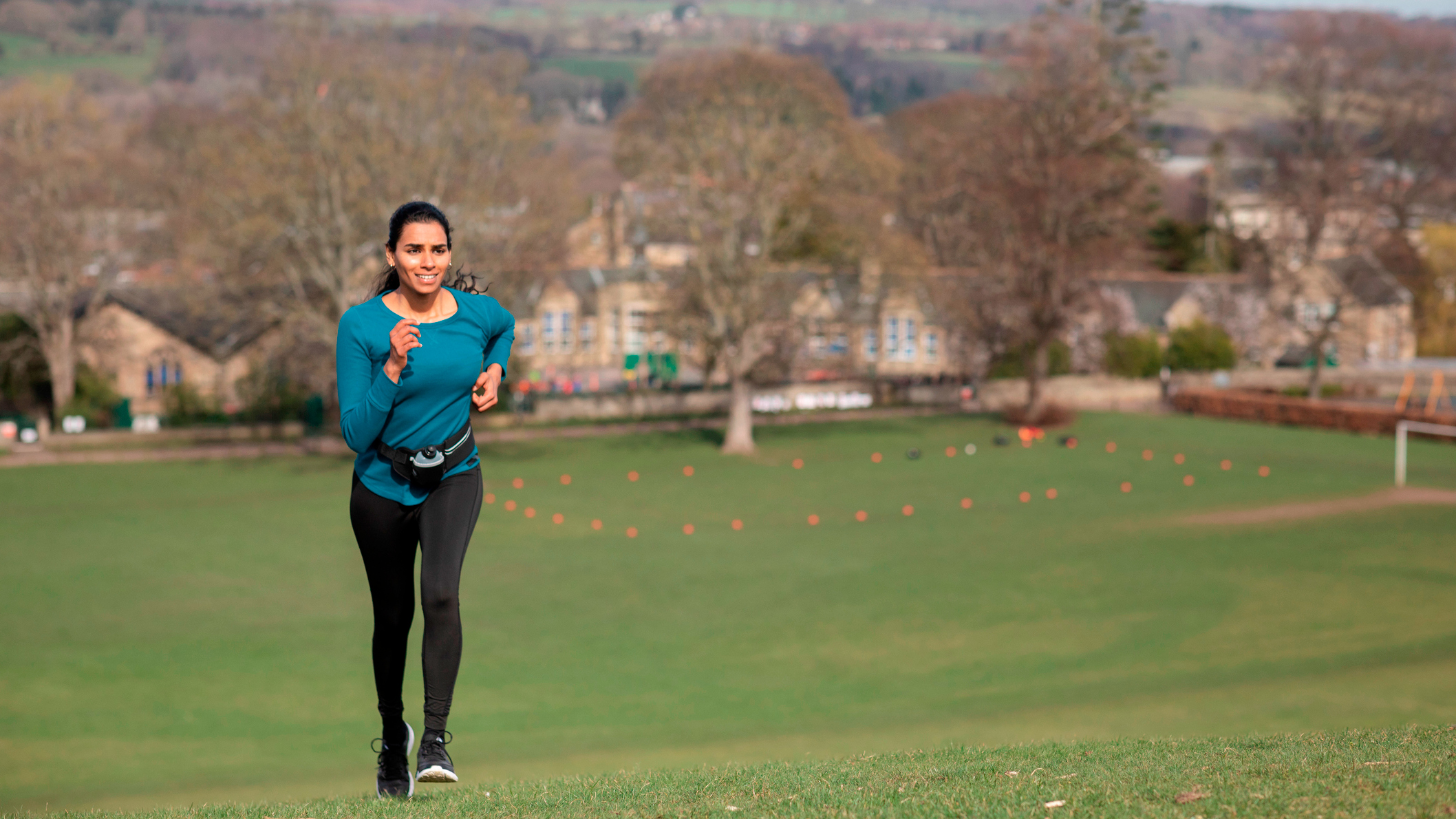
When you first begin running you probably won’t consider the kind of training you do much beyond simply getting out the door a few times a week. And that’s the right approach. The main thing is not to run so hard that it becomes a chore. To help set a consistent running routine and ensure you don’t go too intense too quickly, you could use a Couch to 5K plan.
But once you’ve got that done, it’s time to start mixing up the type of runs you do as part of a structured running training plan. That’s because sticking to the same distances at the same effort level will limit your chances of improving. The good news is that mixing up your training will not only increase your speed, stamina and strength, it’s also fun.
Below you’ll find explanations of eight common types of training run, plus two that are slightly less common. You don’t need to do all of these every week, but you should build your running routine using these blocks. Start with the first couple listed, which should feel comfortable.
1. Base or Easy Runs
Head out the door and run a fairly short distance at a pace that feels comfortable. Easy runs, also known as base runs, are likely to make up the bulk of the distance you cover each week, and they’ll increase your aerobic fitness while allowing you to recover in between harder sessions.
How long easy runs are and the pace you run at depends on the runner, but a good rule of thumb to help ensure you’re not doing them too hard is that you can hold a conversation during them. That’s one tip from our interview with Ben Parker, head coach at running app Runna, in which we asked him all about easy runs.
2. Recovery Runs
These are a distinct type of base/easy runs that are done the day after a hard workout or a long run, when you should ease off the gas and run even slower than you do on base days. The idea here is to help your body recover from a hard effort by keeping your legs moving, and your pace should be comfortable and your heart rate should stay relatively low.
As running coach Ross Murray told us, if you do them right, recovery runs will still help to improve your fitness without really increasing the load you’re putting through your legs.
3. Long Runs
There’s no great mystery here: long runs are long! They’re typically done at the end of a training week with the aim of building your endurance, especially when you’re working up to running a half marathon or marathon. Generally you should do long runs at your base pace, but you can mix in faster sections or do them as progression runs, where you get faster throughout the run.
How long is a long run? Well that depends on the runner, but as running coach Nick Anderson told us, they’re usually around 16-22 miles for marathon runners, and 80-90 minutes for those targeting shorter distances like 5K.
4. Tempo Runs
These are one of the harder runs to define and execute, but generally tempo runs involve running at a comfortably hard pace. As running coach Andy Hobdell told us, “tempo running is where you need to put some effort in to keep up the pace, but you can keep that pace going for a good period of time”.
The benefit of tempo training is that it increases your body’s ability to run faster for longer periods of time, and they are an essential part of the training routine for runners targeting events of any distance.
5. Interval Runs

Here you’re going to run fast, rest (normally this is active recovery, meaning jogging slowly), then repeat that sequence a set number of times. Interval or speed sessions are a key part of the weekly routine of many runners, often done on a track or a flat stretch of road.
How you structure your intervals will determine the benefits you get from them: short, fast sessions doing 400m repeats, for example, will increase your speed and improve your running technique, while longer reps of around 1km will help you build speed endurance so you can hold your target race pace for longer in events.
There are endless ways to vary your interval runs, but the key is to do them regularly—once a week is standard—so you get used to running hard. As triathlon coach Chris Stanton told us, the other important thing is to pace them well so you run each interval at roughly the same pace. In other words, don’t go out too hard then slow down through the final few reps.
6. Fartlek
Another way to get some speed into your routine is to do Fartlek runs. These are similar to interval runs but involve adding faster sections into a continuous base run, either in a structured or unstructured way, rather than running reps on a strict work/rest pattern.
You can do structured Fartlek sessions for time or distance, picking up the pace for 500m here and there during a base run, or keep it loose and opt to sprint 200m whenever, say, you see a dog. Fartlek runs can be good for those who aren’t able to use a running track for their session, because you can pace your intervals on effort rather than pace and take into account the terrain, which might be hilly or muddy.
7. Hill Reps

They’re nobody’s idea of a fun time, but hill training is brilliant for improving your fitness and also your technique and strength. You can do hill reps in a variety of different ways, but to keep things simple just find yourself a hill and run up it hard, jog back down easy, then run up it hard again.
Some runners practice what’s known as Kenyan hill sessions, where you run hard downhill as well and keep going up and down for 10 minutes or longer. These are brilliant for your aerobic fitness, and particularly good for cross-country runners looking to build their speed on the downhills.
8. Progression Run
A progression run is one that starts slow and finishes fast, so you gradually step up the pace along the way. It’s a good way to ease into running at a fast pace without it feeling as daunting.
Long progression runs are also a great way to practice your race pace on tired legs, as well as helping you build stamina and mental strength. They’re perfect for marathoners in particular, since they simulate the way the race will get harder in the second half.
All of the above are common sights on the training plans of runners, but there are other types of runs that people do to target certain goals.
9. Fatmax Run
We learned about fatmax training by speaking to Dr Justin Roberts from Anglia Ruskin University. Fatmax runs are a type of easy run that are done at a specific intensity to maximize the amount of fat used by the body.
“Fatmax is the intensity of exercise at which an individual’s fat oxidation [measured in grams per minute] is at its highest,” says Roberts.
“Fatmax training could be useful to support individuals looking to get into exercise because it is lower-intensity and may suit more people, and may promote better adherence before moving up to higher intensities.”
While fatmax runs will optimize the fat oxidized during your training, it’s important to note that harder runs like interval sessions will burn more calories overall, so if you’re running to lose weight a mix of different runs is advisable.
10. Fasted Run
This is an easy run done without eating or fuelling in any way beforehand (though it's important to stay hydrated). According to Barry Williams, co-founder of Group Evolution, which offers coaching and training camps, one reason people do fasted runs is to try and improve their body’s ability to use fat as fuel.
Another reason is to increase the number of mitochondria in the body. Williams explains why that’s good: “These [mitochondria] are the batteries energizing our muscles, so a greater number of mitochondria is one of the main adaptations we seek through training to improve our physiological potential,” says Williams. “All training has a positive impact but to varying degrees. Fasted running has been shown to stimulate mitochondrial biogenesis more effectively than non-fasted running.”
11. Strides
Strides are not strictly a type of run, but they are an important element of a training plan and can be added into other runs during your week. They look like sprints, but aren’t exactly sprints.
“Strides are intervals of around 100m, run at your one-mile pace,” says running coach Andy Hobdell. “That’s 85-95% effort—a controlled faster effort as opposed to 100% sprints.”
When doing strides you want to ease into the sprint in the first 25m, then run with control for the next 50-60m, before easing off the gas in the final section. Focus on your posture throughout—you want to be upright, running with control and landing on your toes.
There are two main ways runners use strides. One is to finish off a warm-up before speed sessions and races, and the other is to add them on at the end of easy runs. With the latter the strides are serving to stretch the legs out and add some more speed and variety to your training plan, which is especially important during marathon training when you’re doing a lot of mileage mostly at a slower pace.
You recover from a stride by walking 100m before doing another. How many strides you do varies, but four is a good number after an easy run, and you might just do a couple ahead of a race or track session.







